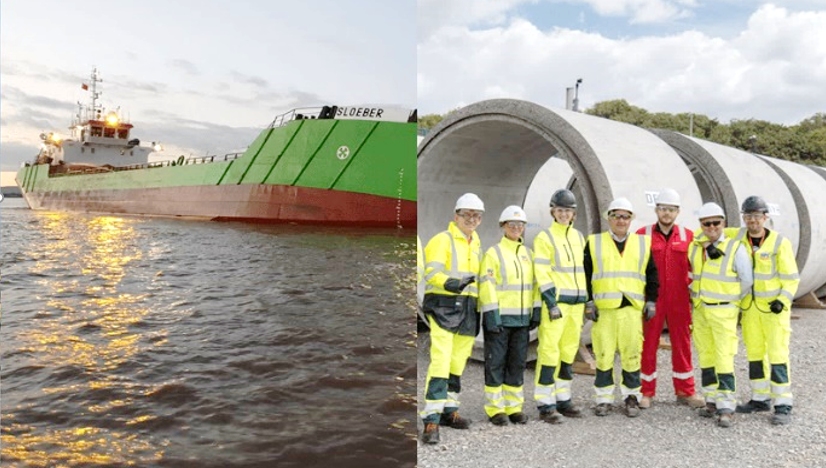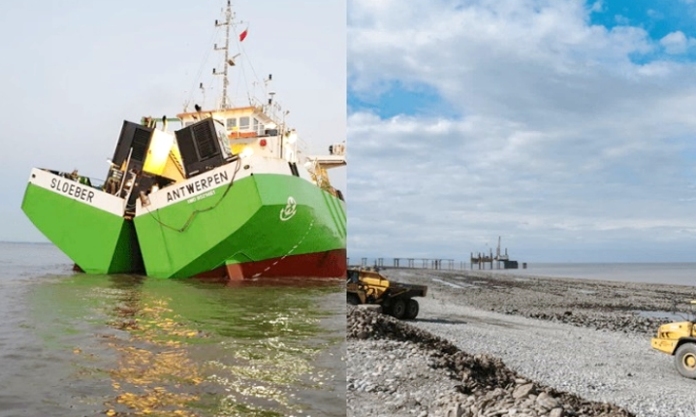Hinkley Point C is due to restart planned mud dredging in 2021 as part of works to install cooling water intakes in the Bristol Channel. Dredging first began in September 2018.
The project is now making applications to regulatory authorities for disposal of mud from the second phase of dredging later in 2021.
Hinkley Point C is making applications to Natural Resources Wales to carry out disposal at the Cardiff Grounds licensed disposal site and to the Marine Management Organisation for the Portishead licensed disposal site.
An EDF spokesman says: “The sediment is typical of sediment found elsewhere in the Bristol Channel, and under UK law it is not radioactive.”

“For this second phase of dredging we have proposed a testing plan that goes above and beyond internationally recognised best practice, with more samples at greater depth and with a greater range of analysis.”
“The applications will include a full Environmental Impact Assessment and the results and analysis of the latest testing of the sediment.”
The maximum volume of mud and sediment being applied for dredging is 469,000 m3, compared to the previous estimate of 600,000 m3.
Either the Cardiff Grounds or Portishead site will be used for the entirety of the disposal – the volume will not be split across the two sites, adds EDF.
Is the mud and sediment radioactive?
EDF says: “The sediment is typical of sediment found elsewhere in the Bristol Channel, and under UK law it is not radioactive.”
“Radioactivity occurs naturally, including in foods we eat, and can be artificial/produced by human activities. Any sediment in UK coastal waters will contain naturally occurring levels of radiation, and in areas of industrial activity there may be extremely low levels of artificial radiation present.”
“In the case of the Bristol Channel, the very low levels of radioactivity identified in the sediment are predominantly naturally occurring, with a small amount of artificial radioactivity, which will have originated from legacy discharges from hospitals, medical isotope manufacturing facilities (including those formerly based in Cardiff) and nuclear facilities. Whether the radioactivity is naturally occurring or artificial this has no impact on how it interacts with the human environment.”
Who carried out the testing?
EDF says: “The tests were carried out by CEFAS, an executive agency of the UK Government. CEFAS has some of the most advanced radiation testing equipment in the world and also provides services to Natural Resources Wales and the Welsh Government, as well as the Marine Management Organisation.”
How thorough was the testing?
EDF adds: “When testing the sediments, the type and energy of radiation, along with the composition of the sample being measured effects how easy it is to measure the amount of radioactivity.”
“Generally, a radioactive atom emits either an alpha or beta particle. This is usually accompanied by a gamma-ray.”
“Due to this fact, the most common means of measuring radiation is to use a technique called gamma ray spectroscopy. This allows you to detect the majority of alpha, beta and gamma emitting radionuclides, identify the radionuclides present and measure the amount radioactivity.”
“As some radionuclides only emit alpha or beta particles, with no gamma-ray, there are some cases where additional testing may be needed, however this is usually not required. In the case of the sampling of the sediments at Hinkley Point C, the testing and sampling plan was developed independently by CEFAS (an executive agency of the UK Government), which carries out work to the highest international standards.”
“The analysis techniques include the use of high resolution gamma-ray spectroscopy, allowing the identification of a wide range of alpha, beta and gamma emitting radionuclides, and thorough assessment of any radioactivity in the sediment.”
“Additional reassurance monitoring, including the use of alpha particle spectroscopy, was undertaken as part of the 2020 sampling campaign to determine the presence of pure alpha emitting radionuclides and tritium. The testing will confirm conclusively that the mud and sediment is safe.”
What were the depth of tests?
The sediment has previously been tested at depth, explains EDF.
“In 2009 CEFAS obtained sediment samples at depths up to 4.8m to support the HPC Planning Application. No artificial radioactivity was observed below 2m. This is likely because any sediment at a depth of greater than 2m depth will have accumulated hundreds if not thousands of years ago, prior to the start of industrial activity in the area.”
“An enhanced sediment sampling plan was developed for the second phase of dredging and took testing even deeper. Surface sampling and sediment samples at depths of up to 9m are planned across 35 sampling stations.”
“In areas not previously dredged (known as capital dredging locations) the cores will extend to the maximum dredge depth, or until expert geotechnical examination reveals that undisturbed geological material has been reached, or the sample consists almost exclusively of sand, gravel or rock. The maximum core length will be 9 m, despite the understanding that sediment found at depths greater than 2m will have no artificial radioactivity.”
“Surface samples were also taken from areas previously dredged during the 2018 dredging campaign (known as maintenance dredging locations). In the case of the dredge depth being greater than the 2018 dredge depth, sampling stations will be sampled according to the capital dredge methodology, described above (i.e. to a depth of up to 9m).”
“A primary reason of increasing sample depths from previous sampling campaign (max 4.8m) is to provide reassurance that this material remains suitable for disposal to sea, and poses no threat to human health or the environment.”







